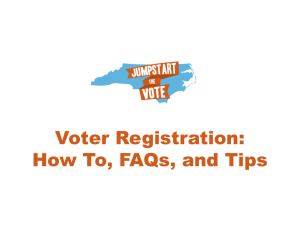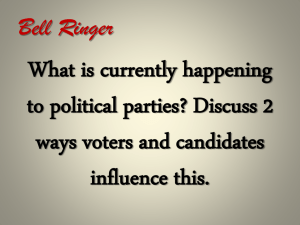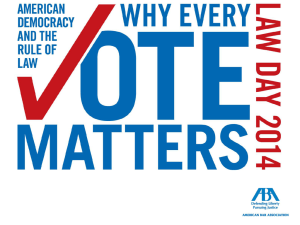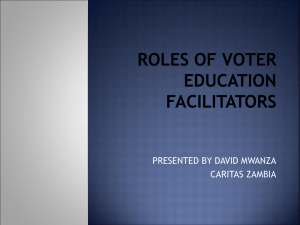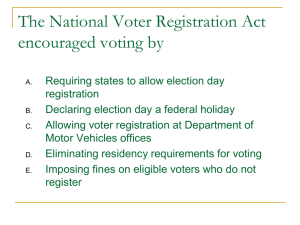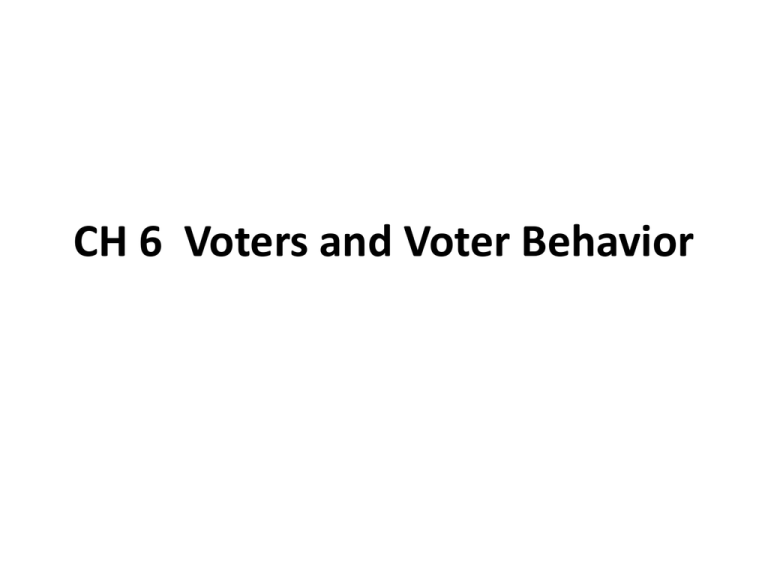
CH 6 Voters and Voter Behavior
Copy:
• Voting is crucial to a democratic society.
• It is a right guaranteed to anyone in the US
who is a citizen and 18 years old.
Suffrage
• 148 the right to vote.
• Electorate
• 148 Those Americans eligible to vote,
registered or not.
registration
• 154
• Procedure of voter identification to prevent
voter fraud.
• One must be registered in order to vote.
• Placed on a list
• Done by party preference
The Right to Vote
• Literacy
• 156 Ability to read and write.
– Once used as a criteria for voter eligibility.
Copy:
• People elect representatives to make their
laws.
• The number of representatives depends on
population in a region.
• Drawing the regions can be done effectively
for good or bad.
gerrymandering
• 159
• Questionable practice of drawing electoral
district lines.
• To set boundaries for people a political official
will represent.
• Done to limit or strengthen the support of a
party or group.
• Redistricting is done after the US census is
done (every 10 years).
Preclearance
• 164 Federal approval of state and local laws
that guarantee fair and equal:
– Poll location
– Boundaries of election districts
– Deadlines in the election process
– Elections from ward to district to at-large.
Copy:
• A voter’s behavior is his/her own.
• It develops from needs, relationships, and
experiences.
Voter Behavior
• 164 Off-year election
• Held in even-numbered years between
presidential elections.
– AKA: midterm elections
Voter Behavior
• Political efficacy
• 166 Voter’s feeling of influence or
effectiveness in their act of voting.
• Political socialization
• Process by which people gain or learn their
political attitudes and opinions.
Voter Behavior
• Gender gap
• 169 difference in male and female voting trends.
• Party identification
• 171 loyalty of a voter to a particular political party.
• Straight-ticket voting
• 171 A voter only supports candidates or issues of
his/her own party.
Voter Behavior
• EC: Split-ticket voting
• 171 a voter supports candidates or issues of
different parties, not just their own party.
• Independent
• 171 any voter who has no party affiliation.
Presidential Election, 2012
• Solid GOP
• Solid Dem
• Which states should a GOP candidate
concentrate on?
• Which states should a Dem candidate
concentrate on?
• Which states must both candidates battle it
out over?
Hwk Concepts, Class Work, to Know
The Right to Vote
Concepts: Ch 6, pp. 148-175
• EC: Describe two long-term trends that have
characterized the history of suffrage in the
United States (2)
– 148 Gradual elimination of voting
restrictions
– Expansion of Federal government’s control
over voting
EC: The Right to Vote
• Describe the five distinct stages in the growth
of the American electorate (5)
– 148 early 1800s, removed religious, property, and
tax payment qualifications
– Post-Civil War: universal male suffrage
– 1920: Women’s suffrage
– 1960s: Civil Rights Acts; 23rd and 24th
Amendments: end poll taxes, and allow District of
Columbia to vote
– 26th Amendment: extends voting age to 18.
EC: The Right to Vote
• What restrictions does the Constitution place
on the States in setting suffrage
qualifications? (3)
– 148 voters must be able to vote in all elections
– No discrimination by race, sex, age (18+)
– No taxes as voter qualification.
EC: Voter Qualifications
• Why do most states require voter registration?
(2)
– 152 prevents fraud
– determines eligibility in closed primaries
EC: Voter Qualifications
• Why do election officials have poll books?
– 152 keep track of all registered voters
• Why are poll books purged?
– 152 keep the books current: eliminate voters
who have moved or passed away, felons.
EC: Voter Qualifications
• Why were poll taxes declared unconstitutional
by SCOTUS?
– 152 only allowed wealthy to vote
– Discriminated against African Americans
EC: Suffrage and Civil Rights
• What is gerrymandering?
– 159 drawing electoral districts to favor a particular party
EC: Suffrage and Civil Rights (5)
• What voting devices were used to
disenfranchise African-Americans?
– 159
– gerrymandering
– Violence
– Social pressures
– Literacy tests
– Poll taxes
The Right to Vote
•
•
•
•
Images:
146: compare to modern campaigning
No technology, only voice
Still involves travelling long distances
Voter Qualifications
•
•
•
•
•
•
Images:
154: questions
A.
Though he has specific opinions about government
and politicians, he feels his vote won’t make a
difference.
B.
That such attitudes are part of the problem.
Voter Qualifications
• Images:
• 155: interpret the graph a, b,
–
–
–
–
–
–
A
10 percent wore a button or put a sticker on their car;
8 percent gave money
4 percent worked in a campaign or for a candidate.
B:
make sure your answer is supported by the graph.
• + what do the last two categories say about people
caring about the outcome? discussion.
EC: Voter Qualifications
Images:
• 156: questions, + what do you think many Jim
Crow states did to avoid the issue?
• They disqualified White, male voters.
Voter Qualifications
• Images:
• 157: question
• Discourages people who might feel they
would fill out the application incorrectly
• Frightens people who might not want their
names to appear in the newspapers.
Voter Qualifications
• Images:
• 158: question,
• That voter apathy is just as dangerous as a
dictatorship.
• + is there really a problem with the US voting
system? Explain.
Voter Behavior
•
•
•
•
Images:
161: questions
1. 15th, 19th, 26th amendments
General trend has been toward a more democratic
(popular) system.
• 162: question.
• About 1.7 million new African American voters
registered.
EC: Voter Behavior (10)
• List sociological factors that affect political behavior
–
–
–
–
–
–
–
–
–
–
164 income
Occupation
Education
Gender (orientation)
Age
Religion
Ethnic background
Geography
Family
Peer groups
Voter Behavior
• 165: questions
• 1968
• 1968
• 166: question
• Nonvoters outweigh the voters
• Suggest their refusal to vote has a huge
impact on elections.
Voter Behavior
• 167: question
• Nonwhites, who have consistently voted
Democratic.
Gerrymandering
270 Map, question
• Neither party wants to lose seats in Congress
as a result of combining districts.
EC: Voter Behavior
• Look at the image on this slide.
• What percentage of voters turned out for the
presidential election in 1964? In 1988?
– Ans: 61.9 percent, 50.1 percent
• Which year shows the greatest difference between
voter turnout for presidential elections versus nonpresidential elections?
– 1984
EC: Voter Behavior
• Look at the image on this slide.
• What percentage of voters turned out for the
presidential election and the non-presidential
election in 1976?
– presidential,
– 53.5 percent;
– non-presidential,
– 34.9 percent
Electoral Process
• You are working on a committee to examine whether 16year-olds in your State should vote. Make up three to five
questions that you would ask 16-year-olds to determine
if they should gain the right to vote.
– Do you read the newspaper, read blogs or Internet sources, or
listen to/watch news about state, national, and world events?
– What is your opinion of our current President?
– What is your opinion of our current Congress?
– Are you concerned about having the right to vote?
– Would you vote in the next general elections if given the
opportunity to do so, and why?
Electoral Process
• What was Benjamin Franklin suggesting about
the government when he said that a man
whose only property was a jackass would lose
his right to vote if the jackass died?
– Franklin may have been suggesting that the
government was biased toward property owners
and that such a bias was unfair because property
ownership in no way makes a person more
qualified to vote.
– One’s rights stay with them all their life.
Electoral Process
• Why is the issue of voter rights so important in
the United States?
– If the United States is to remain a true democracy,
the voting rights of all people must be secured
and guaranteed. Otherwise, certain groups will
not find representation in government and will
not be able to take part by holding public office.
Because the Constitution did not establish voter
rights for all groups, subsequent government
actions had to be taken to do so.


